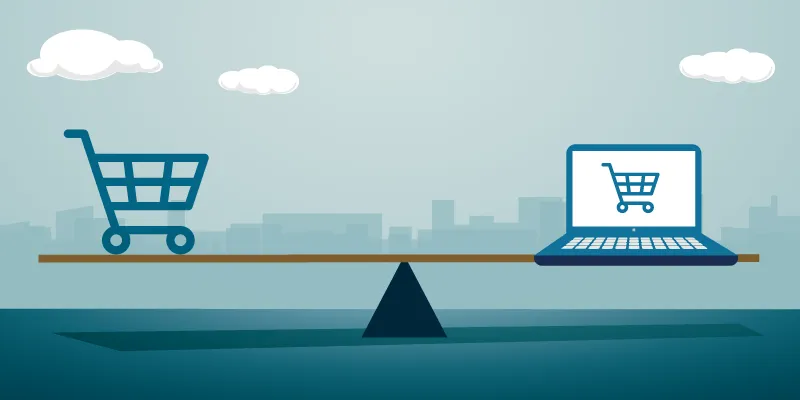Online or offline, which will win the game in the Indian retail landscape?
India’s fast growing retail market is now estimated at close to $625 billion. In a way, it is larger than the E-commerce market that commands robust investment due to the rising numbers of Internet users and computer penetration in the country. If one wants to establish a firm connect between E-commerce and the retail market, then we can say that the offline market is here to stay. As opposed to the retail market, E-commerce's potential landscape is at only about $15 billion now.

Latest statistics reveal there are 14 million retail outlets in India, which implies a demographic distribution of an average of 1,000 shops for 11 users. There, therefore, is a clear and pressing need to build a bridge between the e-commerce and retail space. What better way to do this than the growing online-to-offine (O2O) space.
O2O the buzzword
O2O seems to be the new buzzword in the digital space. Essentially, it’s all about leveraging the digital and mobile medium to drive sales through the offline platforms. In other words, it is about establishing a link between the online discovery of products and then offline transactions for the same. To put it in simpler terms, one should consider O2O as an important space for anything digital, as it pulls people to make further purchases from the offline space in real-world stores. Ideas can often be noble but they need to be relevant to consumers. So it becomes pertinent for retailers to stay ahead of technologies as well.
Consumers are tech and and online-savvy now and explore multiple channels before making their crucial purchase decisions. The ready access to comprehensive data about vendors, products, ratings and reviews maketh a well-informed and demanding consumer. To give them a seamless experience, proper management of a catalogue and inventory are key problems for a retailer. Thus, it has become crucial for a retailer to provide constant and consistent information to all customers at selected touch points. And this is not a tall order as a majority of shoppers exhibit webrooming traits, wherein they look up products online, but buy them in a physical store .
Technologies that are helping O2O
It is worth stating that technologies like beacons provide interactive tools to retailers to execute location-based advertising i.e., advertising the right things to the right/potential consumers at the right time. So, there is a need to bridge the gap between retailers and consumers, provide real-time targeting capability in consonance with the consumers’ location, and all of these help to open up an entirely new horizon for buyers. Consumers, consequently, are enabled to receive customised information on sales, discounts or even launches of new products, purely based on their interest and preferences, which encourage them to visit the neighbourhood store with a commitment to purchase. It’s thus a win-win situation for both the retailer and the customer.
Tools like coupon code (for exclusive offers) and token payments do help in facilitating transactions in a facile manner. But, it definitely takes away the charm of the old-world user experience. Here is where beacons offer a seamless experience to shoppers and help them to close loop on the transaction channel, albeit with some limitations. For instance, Bluetooth has to be switched on in the shopper’s phone to establish a connection with the beacons.
Technology may be daunting to use for those who aren't tech-savvy but it becomes imperative for traditional organisations to evolve in order to navigate through the challenges posed by the O2O space, or vice versa. Contrary to O2O, traditional organisations still have a compartmentalised approach, where two sets of departments exist to handle online sales and offline sales. This anomalous structure often ends up creating a rivalry within an organisation with devastating consequences. I think the way forward should be to integrate both the channels with clearly defined deliverables assigned to each of them.
Having said this, it is important that both online and offline players need to pull their weight and play to their full strength and capabilities in the emerging Indian retail landscape. For online players, it has to be reduced customer acquisition cost, wider assortments and right price points. For retailers, it is trust, instant gratification, service and environment. Bringing both together can create a solid customer proposition that requires partnership across entities.
Players in this space
Currently, players like little, mydala, FirstHandle and nearby are already and aggressively trying to solve the above mentioned problems in this space. In the future, shopping eventually will become extremely personalised, powered by data-driven insights. Online and offline touch points will merge with paramount service, thereby delivering most intuitive customer experience.
China has been leading this O2O revolution so far. If O2O as a concept is so visible in China, it may be because of technologies and their thrust for convenience is making it a big phenomenon with success stories.
Proven technology trends explain the increase of O2O concept in China. First, it’s the large number of people connected through mobile or on mobile Internet. Secondly, instant and voice-based apps help increase the trust, selection and deal-closing. Ronglian Yuntongxun is one such software provider that is working closely with several industries. For example, owing to its voice-based platform, doctors get to have a pre-sale consult with their patients, increasing trust in the first instance and enhancing the potential for closing the deal in the second instance.
With millions of consumers seamlessly connecting to millions of businesses through various technology channels, 2016 is all set to become the year for O2O platform in India.
Investment scenario
The Indian retail market has received equity inflows totalling $155 million in the last six months. Moreover, with the rising need for consumer goods in different categories/sectors, including electronics, food, grocery, apparels, home appliances, the figures are only expected to grow further, establishing the clear need for a proper connect between the retailer and the customer through the O2O space.
While the retail pie size in India is growing rapidly, it is certainly nowhere near a zero sum game between traditional retailers and online retailers in any part of the world. So, it can be safely said that online shopping is still young in India, as is modern brick-and-mortar retail. All in all, some great times for the Indian consumer!
(Disclaimer: The views and opinions expressed in this article are those of the author and do not necessarily reflect the views of YourStory.)







